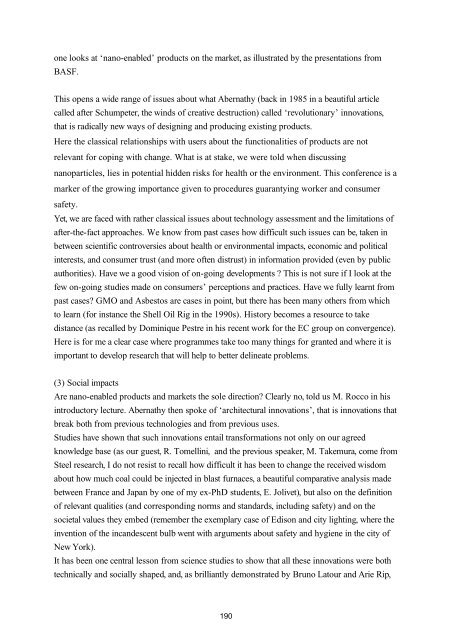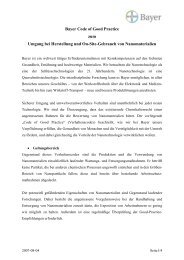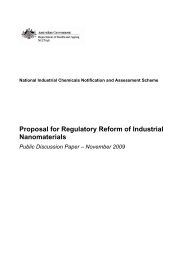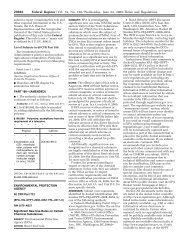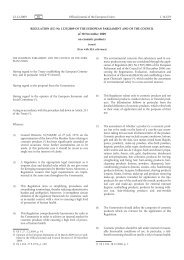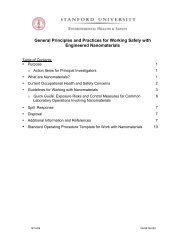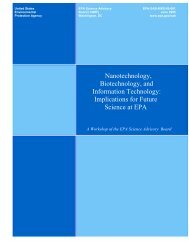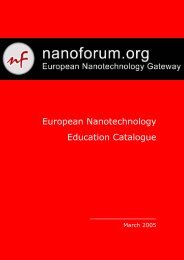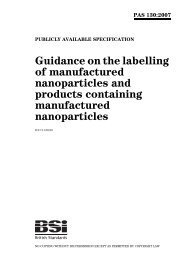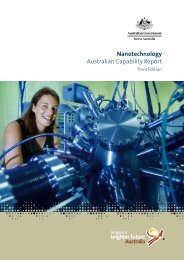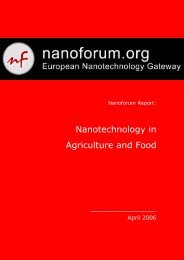Nanotechnology - Nanotech Regulatory Document Archive - Arizona ...
Nanotechnology - Nanotech Regulatory Document Archive - Arizona ...
Nanotechnology - Nanotech Regulatory Document Archive - Arizona ...
You also want an ePaper? Increase the reach of your titles
YUMPU automatically turns print PDFs into web optimized ePapers that Google loves.
one looks at ‘nano-enabled’ products on the market, as illustrated by the presentations from<br />
BASF.<br />
This opens a wide range of issues about what Abernathy (back in 1985 in a beautiful article<br />
called after Schumpeter, the winds of creative destruction) called ‘revolutionary’ innovations,<br />
that is radically new ways of designing and producing existing products.<br />
Here the classical relationships with users about the functionalities of products are not<br />
relevant for coping with change. What is at stake, we were told when discussing<br />
nanoparticles, lies in potential hidden risks for health or the environment. This conference is a<br />
marker of the growing importance given to procedures guarantying worker and consumer<br />
safety.<br />
Yet, we are faced with rather classical issues about technology assessment and the limitations of<br />
after-the-fact approaches. We know from past cases how difficult such issues can be, taken in<br />
between scientific controversies about health or environmental impacts, economic and political<br />
interests, and consumer trust (and more often distrust) in information provided (even by public<br />
authorities). Have we a good vision of on-going developments ? This is not sure if I look at the<br />
few on-going studies made on consumers’ perceptions and practices. Have we fully learnt from<br />
past cases? GMO and Asbestos are cases in point, but there has been many others from which<br />
to learn (for instance the Shell Oil Rig in the 1990s). History becomes a resource to take<br />
distance (as recalled by Dominique Pestre in his recent work for the EC group on convergence).<br />
Here is for me a clear case where programmes take too many things for granted and where it is<br />
important to develop research that will help to better delineate problems.<br />
(3) Social impacts<br />
Are nano-enabled products and markets the sole direction? Clearly no, told us M. Rocco in his<br />
introductory lecture. Abernathy then spoke of ‘architectural innovations’, that is innovations that<br />
break both from previous technologies and from previous uses.<br />
Studies have shown that such innovations entail transformations not only on our agreed<br />
knowledge base (as our guest, R. Tomellini, and the previous speaker, M. Takemura, come from<br />
Steel research, I do not resist to recall how difficult it has been to change the received wisdom<br />
about how much coal could be injected in blast furnaces, a beautiful comparative analysis made<br />
between France and Japan by one of my ex-PhD students, E. Jolivet), but also on the definition<br />
of relevant qualities (and corresponding norms and standards, including safety) and on the<br />
societal values they embed (remember the exemplary case of Edison and city lighting, where the<br />
invention of the incandescent bulb went with arguments about safety and hygiene in the city of<br />
New York).<br />
It has been one central lesson from science studies to show that all these innovations were both<br />
technically and socially shaped, and, as brilliantly demonstrated by Bruno Latour and Arie Rip,<br />
190


